Podcast
Questions and Answers
What material is Peter Randall-Page most known for using in his sculptures?
What material is Peter Randall-Page most known for using in his sculptures?
Which mathematical concepts are prominent in Peter Randall-Page's sculptures?
Which mathematical concepts are prominent in Peter Randall-Page's sculptures?
What does the sculpture 'Seed' (2007) symbolize in Randall-Page's work?
What does the sculpture 'Seed' (2007) symbolize in Randall-Page's work?
In which famous location can the 'Seed' sculpture be found?
In which famous location can the 'Seed' sculpture be found?
Signup and view all the answers
What does Peter Randall-Page get inspiration from for his sculptures?
What does Peter Randall-Page get inspiration from for his sculptures?
Signup and view all the answers
Which is NOT a characteristic of Peter Randall-Page's sculptures?
Which is NOT a characteristic of Peter Randall-Page's sculptures?
Signup and view all the answers
What process does Randall-Page integrate to create his sculptural forms?
What process does Randall-Page integrate to create his sculptural forms?
Signup and view all the answers
Study Notes
Peter Randall-Page: Artist Overview
- Renowned British artist known for large-scale sculptures inspired by nature.
- Explores geometry and rhythms inherent in organic forms like seeds, shells, and rocks.
Organic Inspiration
- Draws inspiration from natural patterns including spirals, repeated designs, and cellular structures.
- Carved stone works reflect organic forms such as fruits and geological formations through repetition and symmetry.
Materials Used
- Primarily works with stone, especially granite and marble, which enables smooth, flowing surfaces.
- Utilizes both hand tools and modern machinery to create textures, highlighting the material's weight and softness.
Mathematical and Geometric Themes
- Influenced by geometric principles found in nature, emphasizing symmetry and tessellation in his sculptures.
- His pieces often reflect mathematical relationships, blending art with the scientific understanding of natural forms.
Public Installations
- Known for large installations in natural settings; these works engage the environment.
- "Seed" (2007) is a notable piece at the Eden Project, featuring a tessellating pattern that symbolizes growth and natural beauty.
Texture and Form
- Sculptures are designed for interaction, with textured surfaces and rounded forms inviting tactile engagement.
- The sensory quality encourages a connection between the audience and the natural elements that inspire his work.
Symbolism in Work
- Carries symbolic meanings concerning life, growth, and transformation; seeds represent potential and the life cycle.
- Abstract forms create a relationship with nature, evoking deeper reflections on existence and the environment.
Notable Works
- "Seed" (2007) at the Eden Project: A monumental granite sculpture.
- "Ridge and Furrow" (1993): Explores geometry and natural rhythms in a large granite piece.
- "Shapes in the Clouds": A series of organic sculptures in public spaces.
Artistic Significance
- Bridges art and science by making abstract natural forms accessible and tangible.
- Widely exhibited globally in museums and galleries, with many public sculptures integrated into environmental and architectural projects.
Studying That Suits You
Use AI to generate personalized quizzes and flashcards to suit your learning preferences.
Description
Explore the artistic journey of Peter Randall-Page, a renowned British artist celebrated for his large-scale sculptures inspired by natural forms. This quiz delves into the geometry and rhythms of nature influencing his work, as well as the mathematical and biological processes behind natural growth and form.




